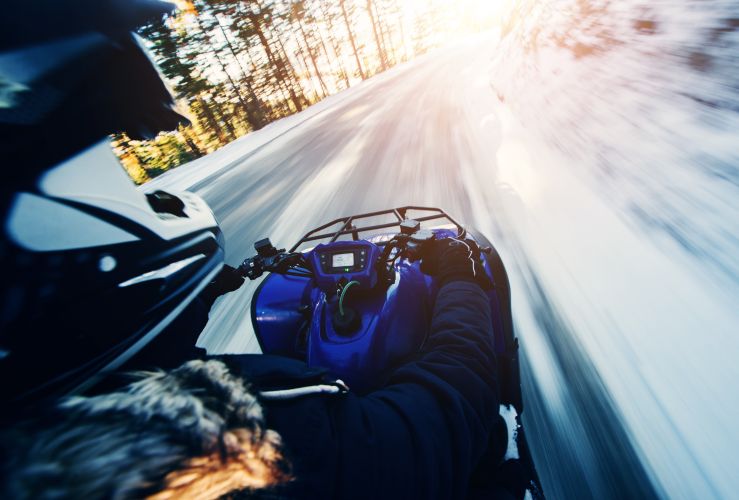Most motorcycle owners store their machines away for the winter, concerned that riding in colder months is both unpleasant and risky.
If you’re planning on doing the same, we have some handy tips for storing your motorcycle safely and securely over winter.
Planning to use your motorcycle over winter?
Ice and motorcycles do not mix well, but that doesn't mean winter riding is impossible.
For safer winter riding, here are our five winter riding tips…

1. Keep your speed down
Part of the pleasure of riding a motorcycle is the speed - but in ice and snow, speed is your enemy.
When riding your motorcycle in winter, use that accelerator gently and avoid doing anything suddenly - be it braking, swerving, cornering - or speeding up.
2. Understanding your tyres
Be aware your tyres cool down quickly
As your tyres heat up, your traction improves. But in colder weather, your tyres cool down quicker as soon as you stop.
This means waiting at traffic lights for a minute results in tyres that are as cold as when you first fired up the engine - reducing your traction accordingly.
Check your tyre pressure and tyre tread
Before heading out make sure you check your motorcycle’s tyre pressure and that you have adequate tread on your tyres for winter riding.
Lack of tread will make it more difficult to channel water on wet roads.
Not having enough tread, or incorrect tyre pressure will result in less traction, which also means longer stopping distances.
3. Sort out motorcycle roadside assistance
Investing in a good quality roadside assistance policy will give you the peace of mind that if you do break down this winter, you'll get the help you need - fast.
Take a look at Start Rescue's roadside assistance service for motorcycles.
4. Should you stay home?
When is it too cold to ride a motorcycle?
It is not recommended to ride a motorcycle when the temperature falls below freezing (32°F or 0°C)
Below freezing, ice will start to form. Bikes, being much smaller vehicles, are susceptible to such conditions. It is harder to keep traction on a bike in icy conditions
If you have no option but to ride your motorcycle in such cold temperatures, you should ensure that you’re wearing the proper gear. Indeed, riding your bike in temperatures below 10°C can affect you physically in a very short time if you are not wearing appropriate clothing.
A cold rider can experience slower reaction times due to feeling the cold, will have less coordination and may struggle to operate their bike’s controls.
Stay at home if it snows
While you may be able to handle wind and even ice, when it starts to snow, you should stay at home.
Crucially, visibility becomes extremely poor, meaning you cannot spot other road users, black ice, sharp curves and all manner of other hazards.
If it starts to snow while you’re on your bike, find somewhere to hunker down while it passes.
5. Wear suitable motorbike gear
If you're dead-set on winter riding, spend some of your hard-earned money on high quality boots, pants, jacket, gloves and a full-face DOT-approved helmet.
The best way to stay warm on your motorcycle in winter, is to wear layers. These layers should fit snugly but not be restrictive.
One key winter riding tip is to stay dry. Outer layer made from Gore-Tex are a popular choice among bikes due to the material’s breathability whist also offering waterproofing,
You might even invest in heated boot-liners, handlebars and jackets, although it can take a while to hook yourself up before each ride.
For a more in-depth look into staying warm on your motorcycle, check out our article on staying warm on your motorcycle this winter.
How to start a motorcycle in the cold
Struggling to start your motorcycle in the colder weather?
There are usually two main reasons why your motorbike is struggling to start in winter:
Battery Issues
Colder temperatures can drain motorcycle batteries quickly.
Check your motorcycle's battery voltage using a multimeter; if you see that the battery is low, charge for a few hours before trying to start it up.
If your motorcycle battery is old, you may need to consider changing the battery.
On average the lifespan of a motorbike battery is 3 to 4 years.
Thickening of the engine oil
Motorcycle engine oil can thicken in colder temperatures.
You should choose an appropriate high quality oil for your motorbike.
Multi-grade oil maintains viscosity across a wide temperature range.
However, the additives in multigrade oil which make it so effective do degrade over time, and so regular oil changes are required for your motorcycle, to maintain effectiveness.
Synthetic oils can outperform regular oils in some circumstances. Due to their molecular structure, they are known for their capability to start up engines in lower temperatures
However, only the oil types recommended by the manufacturer of the motorcycle should be used
Any steps that you can take to keep your motorcycle warm and from the elements, such as Keeping a motorcycle in a garage overnight, or using an insulated bike cover can help decrease the thickening of oil.




